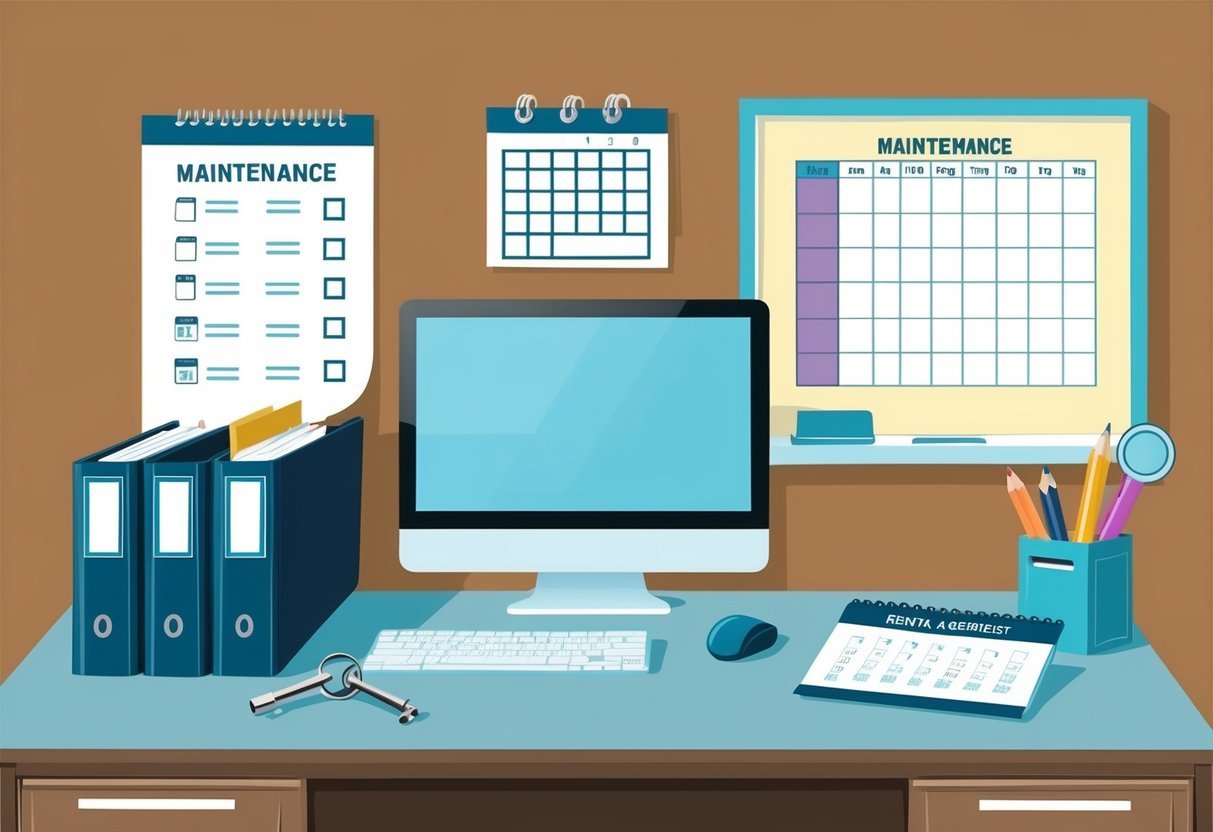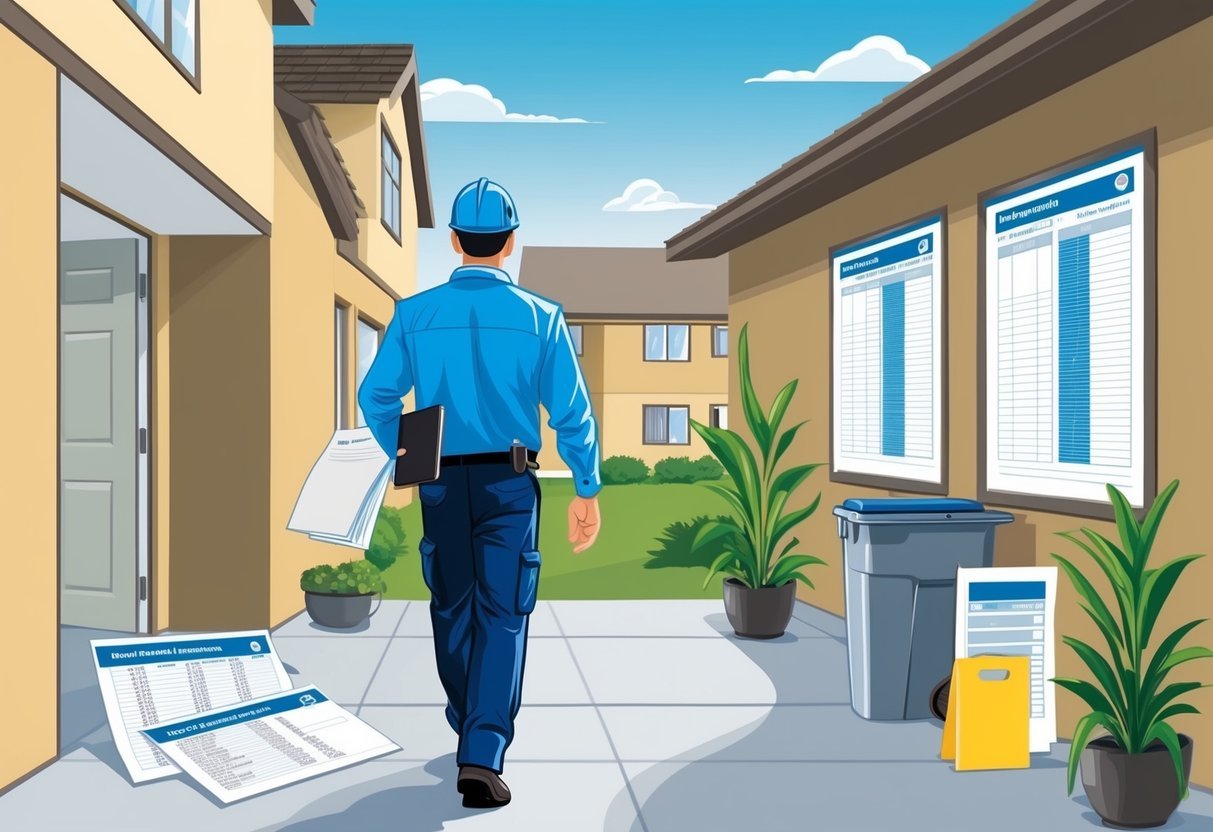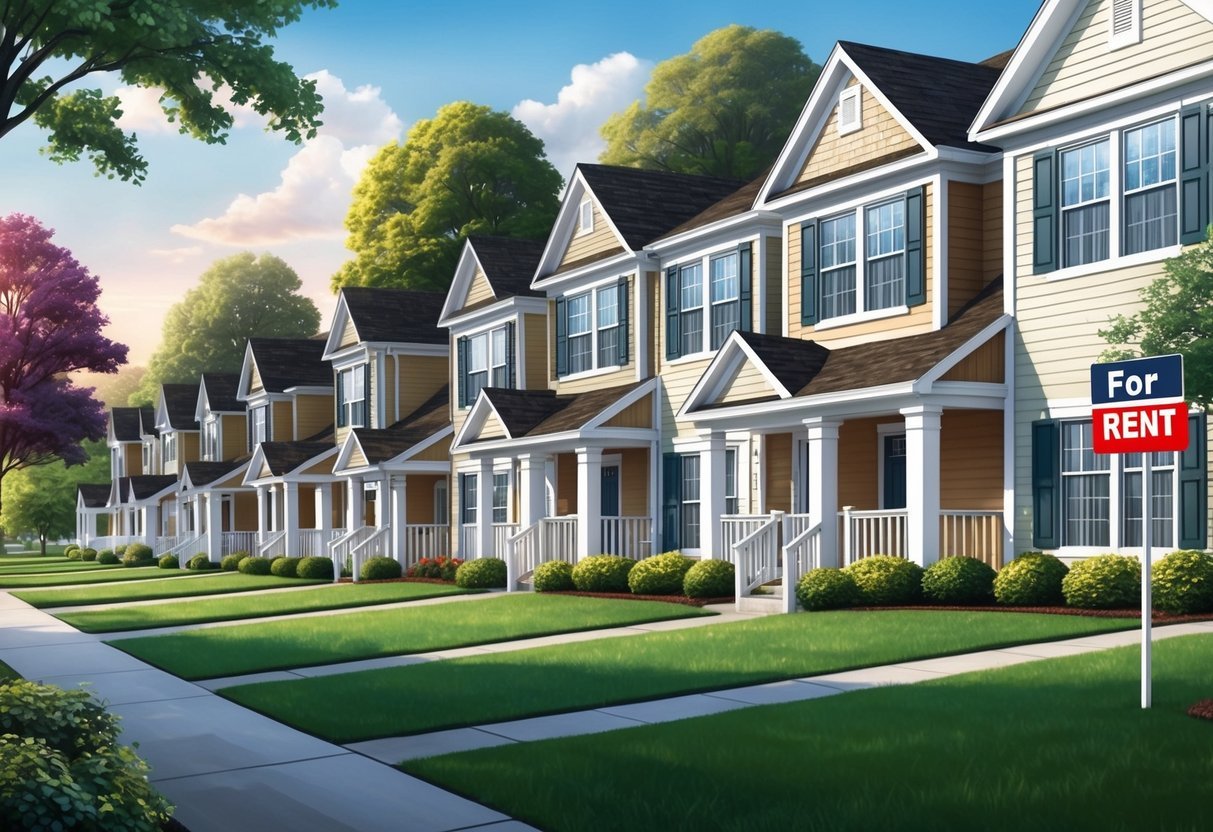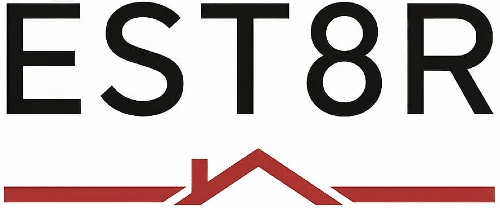In today’s ever-evolving real estate market, managing rental properties effectively has become essential for success.
As property managers, we face a landscape filled with both opportunities and challenges that require a strategic approach.
It is critical for us to stay informed and adapt our practices to ensure both tenant satisfaction and profitability. By implementing the right strategies, we can maximize returns while maintaining a well-managed property portfolio.

It’s no secret that property management involves a diverse range of tasks from tenant relations to financial oversight.
We need to be proactive in addressing each aspect to ensure our properties thrive.
With the right tools and techniques at our disposal, we’re able to enhance operational efficiency, boost tenant retention, and achieve sustainable growth in our rental business.
1) Screen Tenants Thoroughly
When managing rental properties, one of the most critical steps is to screen tenants thoroughly.
This process helps us ensure that we select reliable and responsible renters.
It begins with an in-depth rental application where we gather essential information about the applicants.
Running a credit check provides us insight into an applicant’s financial history and payment habits.
This helps us assess their ability to pay rent consistently.
A background check is equally important, allowing us to identify any past legal issues that could affect their suitability as tenants.
Another key component is verifying the applicant’s employment.
By confirming their income and job stability, we increase our confidence in their ability to meet rental payments.
Additionally, contacting previous landlords adds another layer of clarity regarding their rental history and relationships with past property managers.
We might also consider conducting in-person or virtual interviews.
Asking clarifying questions during these interviews gives us a better grasp of the applicant’s lifestyle and intentions for renting.
This step can highlight potential red flags that aren’t apparent from the application alone.
Through these comprehensive screening practices, we are better positioned to find tenants who are likely to maintain our property well and adhere to lease agreements.
A thorough tenant screening not only protects our investment but also ensures a more harmonious landlord-tenant relationship moving forward.
2) Maintain Open Communication
Maintaining open communication is essential in fostering positive relationships with our tenants.
By being accessible and responsive, we can quickly address any issues or concerns that may arise during the tenancy.
This proactive approach helps prevent misunderstandings and potential disputes, creating a more harmonious living environment.
We should invest in effective communication tools.
Technologies such as maintenance request software and property management systems can streamline our interactions with tenants.
These tools enable us to respond to inquiries swiftly and ensure all parties are on the same page regarding property matters.
Face-to-face meetings still play a crucial role in effective communication.
For important discussions, we prioritize in-person interactions whenever possible, as this provides clarity and reduces the risk of misinterpretation.
Personal engagement can significantly enhance trust and understanding between us and our tenants.
Setting clear expectations at the beginning of the tenancy is vital.
During the lease signing, we outline property rules, maintenance responsibilities, and preferred communication methods.
This establishes a shared understanding, helping to avoid conflicts over unmet expectations down the line.
Building strong relationships requires us to continually refine our communication strategies.
Regularly soliciting feedback from tenants can highlight areas for improvement and demonstrate our commitment to meeting their needs.
Open dialogue also encourages tenants to voice any concerns before they escalate.
By keeping our communication channels open and transparent, we set the foundation for a successful landlord-tenant relationship.
This not only enhances tenant satisfaction but also contributes to higher retention rates, ultimately benefiting both parties involved.
3) Keep Up with Maintenance

In managing rental properties, maintenance is crucial and can significantly impact tenant satisfaction.
By maintaining properties well, we ensure a safe and comfortable environment for our tenants.
This proactive approach can also prevent minor issues from becoming costly repairs.
Communication is key.
We’ve found that establishing clear responsibilities between us and our tenants helps streamline maintenance tasks.
Generally, we handle major repairs, while tenants are responsible for basic upkeep.
This structure keeps expectations clear.
Regular inspections are another important step.
This practice allows us to identify and address problems early.
We can schedule routine checks to examine vital components like plumbing and electrical systems, ensuring they operate efficiently and safely.
Keeping a reliable list of contractors is beneficial.
Having trusted professionals ready for plumbing, electrical, and other repairs helps us respond quickly to maintenance requests.
This helps us maintain property value and protects us against unexpected problems.
Budgeting for maintenance is crucial.
Allocating funds for repairs and upkeep prevents financial strain when issues arise.
By setting aside a portion of rental income for this purpose, we can handle unexpected expenses without disrupting cash flow.
Our tenants appreciate quick and efficient responses to their concerns.
A system for logging maintenance requests helps us track issues and prioritize urgent tasks.
By doing so, we foster a positive relationship with tenants, which in turn supports tenant retention.
Staying informed about local regulations regarding property maintenance keeps us compliant with laws.
This knowledge helps us avoid potential legal problems and ensures that we provide safe housing.
Regularly updating our processes to adhere to new regulations is part of responsible property management.
4) Offer Online Payment Options

In today’s digital age, providing online payment options is essential for property management.
Tenants appreciate the convenience this method offers, allowing them to settle rent payments swiftly from their smartphones or computers.
By incorporating online systems, we simplify the transaction process, making it more efficient for both parties.
Offering various online payment methods can better accommodate tenant preferences.
Options such as one-time payments, direct debit, or automatic payments ensure flexibility.
Tenants can select the method that best suits their financial management style.
This flexibility can enhance tenant satisfaction and encourage timely payments.
Online payment systems often come with tools that help us track and manage transactions.
These tools can automatically update payment records, reducing manual entry and potential errors.
With better organized financial records, we can easily generate reports for our accounting needs.
Implementing online payment platforms also opens the door to additional features like automatic late fee calculation.
Should a tenant miss a payment deadline, these systems can automatically add the necessary late fees.
This feature not only enforces our rental agreements but also helps maintain consistent cash flow.
Security is a primary concern when dealing with online transactions.
Most reputable online payment systems offer advanced encryption to protect sensitive information.
By choosing a secure platform, we ensure tenant data is safe, fostering trust and reliability in our management practices.
Online payment options offer a modern solution to an age-old task.
By embracing these digital tools, we streamline operations, foster tenant satisfaction, and maintain a professional standard in managing our properties.
5) Adhere to Local Laws

Compliance with local regulations is crucial for rental property management.
We must familiarize ourselves with zoning laws, building codes, and tenant rights applicable in the area.
Understanding these laws helps us avoid legal disputes and ensures we operate within the legal framework.
Every locality has specific rules regarding tenant agreements.
Detailed, transparent lease agreements are essential, outlining all mutual responsibilities.
We need to include clauses addressing issues like rent payment schedules, maintenance responsibilities, and notice periods to ensure clarity for both parties.
Screening tenants must be conducted within the legal guidelines, ensuring it is a fair and non-discriminatory process.
We must be cautious to follow fair housing laws, which prohibit discrimination based on race, color, national origin, religion, sex, familial status, or disability.
Respecting these laws protects us from potential lawsuits.
Maintenance responsibilities are another critical area governed by local laws.
We are obligated to ensure our properties meet habitability standards, providing a safe and livable environment.
Regular inspections and prompt repairs help us maintain compliance and keep tenants satisfied.
Local tax laws also influence rental property management.
We need to remain informed about property tax rates and any potential tax benefits.
Proper accounting and timely tax payments prevent financial penalties and contribute to effective financial planning.
By adhering to local laws, we not only avoid legal issues but also foster a positive reputation in the community.
Staying informed and proactive in our approach to these legal requirements enhances our management practices and strengthens our tenant relationships.
6) Regular Property Inspections

Regular inspections are crucial for maintaining the quality and value of our rental properties.
By conducting routine checks, we ensure that our properties remain in excellent condition and identify issues before they become costly repairs.
Our goal is to maintain a safe and welcoming environment for tenants.
Effective inspections help us assess the functionality and compliance of properties, covering aspects such as electricity, plumbing, safety features, and structural integrity.
It is essential to have a comprehensive checklist to guide us through each inspection, ensuring nothing is overlooked.
We should always notify our tenants in advance before conducting inspections.
This fosters transparency and helps maintain a good landlord-tenant relationship.
In our inspections, we examine both the interior and exterior of properties, from walls and ceilings to appliances and landscaping.
After each inspection, we provide tenants with a detailed report, outlining any issues identified.
This report serves as a basis for scheduling necessary repairs or maintenance.
Documenting each inspection helps us track the property’s condition over time and hold parties accountable when damages occur.
There are different types of inspections that we should conduct.
Move-in inspections establish a property’s condition before a new tenant arrives, while drive-by inspections assess a property’s exterior for visible issues.
Each type of inspection serves a unique purpose in our management strategy.
Finally, regular inspections not only protect our investment but also enhance tenant satisfaction, as they appreciate a well-maintained living space.
Our proactive approach in conducting inspections is key to successful rental property management.
7) Have Clear Lease Agreements

Ensuring our lease agreements are clear and comprehensive is fundamental in property management.
A well-drafted lease serves as the foundation of a smooth landlord-tenant relationship.
It delineates the terms, conditions, and expectations from both parties, providing a reference point if disputes arise.
When creating a lease, clarity is paramount.
We need to use precise and unambiguous language to avoid misunderstandings.
It’s important that our agreements cover essential elements such as rent amount, due dates, and the duration of the tenancy.
Defining responsibilities within the lease is essential.
We must outline who handles property maintenance and specific areas that the tenant should control, like routine cleaning.
This aids in preventing conflicts about maintenance duties and keeps the property in good condition.
Another critical aspect is the inclusion of rules regarding alterations.
We should clearly state what changes, if any, a tenant can make to the property.
Doing so sets boundaries and helps maintain the property’s value.
We should also highlight the procedures for lease renewal or termination.
Providing guidelines on the notice period required for either party ensures transparency and gives both parties adequate time to make necessary arrangements.
Including clauses on pet policies or noise restrictions can further prevent issues during the tenancy.
These specific stipulations should reflect our property’s unique characteristics and address any recurring concerns we’ve encountered in the past.
Having a clear section on financial aspects, such as security deposits and possible fees, is equally important.
By being upfront about potential costs, we can mitigate surprises and foster trust.
Ensuring our lease agreements comply with local rental laws protects both parties and maintains the integrity of our management practices.
Engaging a legal professional to review the document can enhance its robustness.
8) Maintain Accurate Records

Accurate record-keeping is essential for effective rental property management.
We make it a point to clearly document every interaction with tenants, from screening reports to signed lease agreements.
This not only streamlines our operations, but also protects us legally.
Utilizing a good system for organizing documents helps immensely.
We keep detailed records of maintenance requests, financial transactions, and tenant communications.
Digital tools and software can simplify this process, making access to important information easy and efficient.
Financial record-keeping is another critical area.
It’s vital to maintain separate accounts for personal and rental property finances to avoid any mix-ups.
This helps us evaluate the financial performance of our properties and ensures clarity when tax season rolls around.
We also pay attention to legal documents and correspondence, including eviction notices and lease violations.
Retaining these records supports compliance with legal standards and protects our interests.
Organizing these documents well ensures we can quickly retrieve information when needed.
Regular audits of our records help us identify inaccuracies or gaps in documentation.
Checking our files periodically can prevent small issues from turning into significant problems later on.
By consistently maintaining our records, we improve our efficiency and ensure smooth property management operations.
9) Handle Repairs Promptly

When managing rental properties, addressing repair needs swiftly is crucial.
Prompt handling of repairs can prevent minor issues from escalating into more significant problems, saving us time and money in the long run.
Establishing a clear protocol for receiving and responding to repair requests can streamline the process.
Tenants should have an easy way to report issues, whether through an online portal, email, or phone call.
This helps us assess the situation quickly and take appropriate action.
We should also ensure we have a reliable network of contractors and handymen to address various repair needs.
Having pre-vetted professionals ready to assist reduces downtime and helps ensure repairs are done correctly the first time.
Regular maintenance checks can also help us spot potential problems early.
Scheduling routine inspections for systems like HVAC, plumbing, and electrical can help us deal with issues proactively before they become emergencies.
By managing repairs and maintenance efficiently, we enhance tenant satisfaction and contribute to higher retention rates.
When tenants see that we care for the property and their comfort, they are more likely to renew their leases and recommend our properties to others.
10) Price Competitively

As landlords, finding the right balance in setting rental prices is crucial for our success.
We need to make sure our property is attractive to prospective tenants while also ensuring it meets our financial goals.
To do this, we should conduct a thorough market analysis and avoid setting prices too high or too low.
First, understanding local supply and demand dynamics can give valuable insights.
If there is high demand and low vacancy rates, we could justify slightly higher rents.
Conversely, if vacancy rates are climbing, adjusting prices to be more competitive could help us avoid prolonged vacancies.
Our rental property’s features also play a significant role in pricing strategy.
Unique attributes like a great view, modern appliances, or proximity to transportation hubs can allow us to ask for a premium.
Conversely, if the property has drawbacks compared to others, we may need to consider pricing slightly lower to attract interest.
Analyzing comparable properties in the area is another vital step.
We should take note of similar units’ rent levels and tenant feedback.
By doing this, we’re better equipped to set a rate that is neither unattractive nor undervalued.
Finally, staying informed about market trends and economic changes is beneficial for making timely price adjustments.
With our knowledge and strategic pricing, we can ensure our rental remains competitive and appealing to potential tenants.
11) Market Your Properties Effectively
Effective marketing is crucial for reducing vacancy rates and attracting high-quality tenants.
We should start by investing in professional photography.
High-quality images that highlight the best features of our properties can significantly boost interest.
Alongside great visuals, our property listings need detailed and accurate descriptions.
Describing not just the property, but also nearby amenities and attractions, can help potential tenants envision their new home.
Leveraging online platforms is essential.
We can choose popular real estate websites and social media channels for our listings.
Engaging posts and regular updates keep our properties in potential tenants’ minds.
Virtual tours offer additional appeal.
By providing immersive 3D experiences, we allow potential tenants to explore our properties without having to visit in person.
This convenience can be a strong selling point.
Networking within the local community also boosts visibility.
We can connect with local businesses or community groups that might know individuals seeking rental homes.
Building these relationships can be mutually beneficial.
Renters are not only looking for homes; they’re looking for communities.
Hosting open houses or virtual events introduce potential tenants to the neighborhood and help build connections.
Lastly, collecting and showcasing positive testimonials from current or past tenants strengthens credibility.
Word-of-mouth and authentic reviews can influence prospective renters’ decisions.
Using a multi-channel approach in our marketing strategy ensures we reach a wider audience while presenting our properties in the best light possible.
12) Implement Safety Measures
Ensuring the safety of our rental properties is essential for both tenant satisfaction and legal compliance.
We should begin by researching and adhering to local safety regulations and building codes.
This sets a strong foundation for all our safety protocols and helps avert potential legal issues.
Regular safety inspections should be a staple in our management routine.
Evaluating properties for risks such as faulty wiring, slippery walkways, or inadequate lighting is crucial.
Identifying these hazards early can prevent accidents and maintain a secure living environment for our tenants.
We must equip our properties with functioning smoke and carbon monoxide detectors.
Testing these devices regularly ensures they are operational and ready to alert tenants in case of an emergency.
Additionally, maintaining secure doors and windows is vital for keeping unwanted intruders at bay.
Encouraging a collaborative approach to safety by educating tenants on best practices can further enhance security.
By providing a clear safety checklist, we empower them to contribute to the property’s overall well-being.
This collaborative effort fosters a sense of community and shared responsibility.
Organizing a neighborhood watch program can also be beneficial, especially in larger communities.
This proactive approach not only deters criminal activity but also strengthens the sense of safety among tenants.
Active participation from both management and tenants is key to its success.
Understanding Legal Requirements
In rental property management, adhering to legal obligations is crucial.
We need to be aware of local and state regulations, alongside tenant rights and responsibilities, to ensure compliance and foster a positive landlord-tenant relationship.
Local and State Regulations
Each jurisdiction imposes unique rules that landlords must follow when managing properties.
These regulations can address various matters such as rent control, security deposits, eviction processes, and building codes.
Staying informed on these regulations helps us avoid legal issues.
Landlords are encouraged to regularly review their local housing authority’s guidelines. Continuous education on relevant laws is vital, as these regulations can evolve.
It’s essential that we align our rental agreements with these statutes to remain compliant and avoid costly penalties.
Further, consulting with legal professionals for complex situations can provide clarification and assurance in meeting these requirements.
Tenant Rights and Responsibilities
Understanding tenant rights and responsibilities is a key facet of effective property management.
Tenants typically have the right to safe and habitable living conditions.
As landlords, we must ensure that the property meets health and safety standards.
This includes addressing necessary repairs promptly and respecting tenant privacy.
Equally, tenants have obligations such as paying rent on time, maintaining the property, and adhering to the terms of the lease agreement.
By fostering a mutual understanding of these rights and responsibilities, we can minimize disputes and enhance tenant satisfaction.
Encouraging clear communication channels between us and the tenants further helps in addressing issues amicably and efficiently.
Effective Tenant Screening
Effective tenant screening helps us ensure that potential renters are reliable and suitable.
A comprehensive process involving background, credit, and reference checks can significantly reduce the risk of future issues.
Background and Credit Checks
When managing rental properties, conducting background checks is crucial.
We examine potential tenants’ criminal records to ensure a safe environment.
It’s essential to balance thoroughness with compliance to fair housing laws.
Credit checks offer insight into financial responsibility.
We assess credit scores and look for patterns of consistent payments or any red flags like bankruptcy.
By evaluating this data, we better understand their ability to meet rental obligations.
Transparency is key, so we must inform applicants about these checks and obtain their consent.
Reference Checks
Reference checks provide a clearer picture of a tenant’s behavior and reliability.
We contact previous landlords to gather insights about their rental history.
Questions about timely rent payments, upkeep of the property, and overall behavior are essential.
References from employers can also provide a sense of job stability and income.
This step helps us confirm the information provided and highlights trustworthy candidates.
Keeping these conversations professional and respectful strengthens our screening process, allowing us to make informed decisions about potential tenants.
Property Maintenance and Upkeep
Keeping rental properties in optimal condition requires strategic maintenance and immediate attention to repairs.
Proactive approaches can result in satisfied tenants and protect our property investment in the long term.
Routine Inspections
Regular inspections form the foundation of a well-maintained property.
By scheduling these inspections, we can identify potential issues before they escalate.
Recognizing problems early allows us to plan budget-friendly repairs, minimizing unexpected costs. Key areas to inspect include HVAC systems, plumbing, roofing, and electrical installations.
During these checks, we should assess the overall condition and ensure compliance with safety standards.
It’s vital to keep a detailed record of all inspection findings and subsequent fixes.
This not only aids in maintaining property history but also enhances tenant trust and satisfaction.
Emergency Repairs
Emergencies, such as water leaks or heating failures, demand swift attention to prevent further damage.
We can ensure that repairs are executed promptly by establishing a reliable network of trusted vendors.
We must also communicate clearly with tenants.
This includes informing them of anticipated repair timelines and any actions they may need to take in the interim.
Having an emergency fund dedicated to such repairs ensures we can address issues without delay.
It’s also beneficial to prioritize efficient problem-solving strategies.
As landlords, our ability to handle emergencies effectively can significantly influence tenant relations.
Frequently Asked Questions
Managing rental properties involves addressing varied responsibilities and overcoming challenges.
Our focus is on areas such as property maintenance, tenant management, and leveraging technology to enhance efficiency.
How can I efficiently manage multiple rental properties?
Effectively managing multiple properties requires organization and strategic delegation.
We can utilize property management software to track rent, maintenance, and tenant communication.
This helps us stay organized and manage workloads efficiently.
Assigning tasks to capable team members is also crucial to ensure that no aspect of management is overlooked.
What are the critical responsibilities of a property manager?
Property managers have several key duties, including tenant screening and property maintenance.
We must enforce lease agreements and handle legal compliance, ensuring adherence to local regulations.
Regular property inspections and addressing tenant concerns promptly are also important aspects of our role.
What are the main challenges faced in property management?
Challenges in property management often include resolving tenant disputes and keeping up with maintenance.
Additionally, we also face the challenge of dealing with unpredictable situations like emergencies.
This is while ensuring compliance with ever-changing legal standards.
We also face the challenge of maintaining consistent cash flow.
How can technology aid in managing rental properties remotely?
Technology provides us with tools such as online payment systems and virtual property tours.
These platforms facilitate seamless communication and remote management.
They allow us to handle tasks such as rent collection and maintenance requests more efficiently from a distance.
What strategies can I employ to handle tenant relations effectively?
Building strong tenant relationships involves maintaining open communication and promptly addressing issues.
We can establish clear, fair policies from the start and offer flexible payment options.
Regular updates about property matters also keep tenants informed and build trust.
How do property management companies streamline their operations?
Property management companies often streamline their operations by adopting digital solutions for tracking and communication.
Digitalizing workflows and automating repetitive tasks enhances efficiency.
They also rely on cross-functional teams to collaborate and address various property-related issues efficiently, improving service quality.

